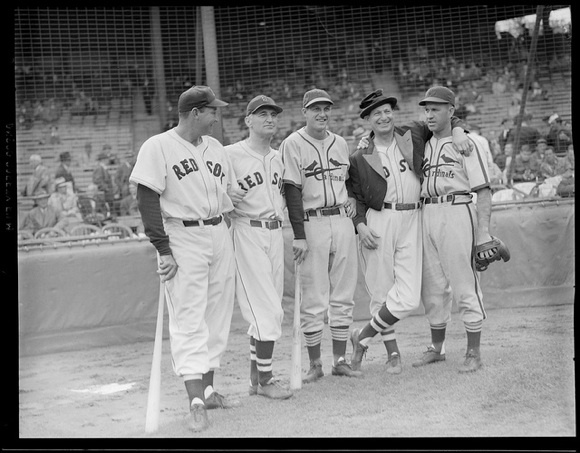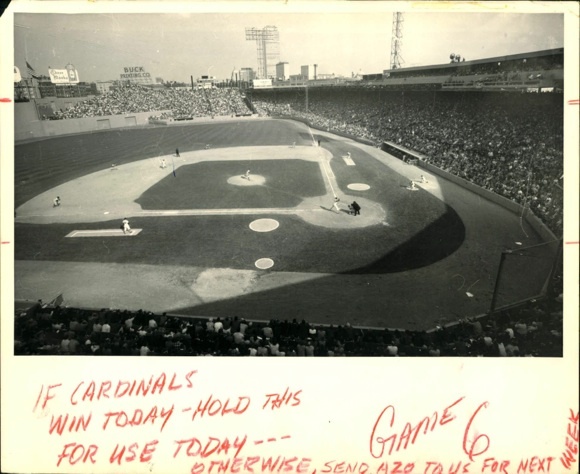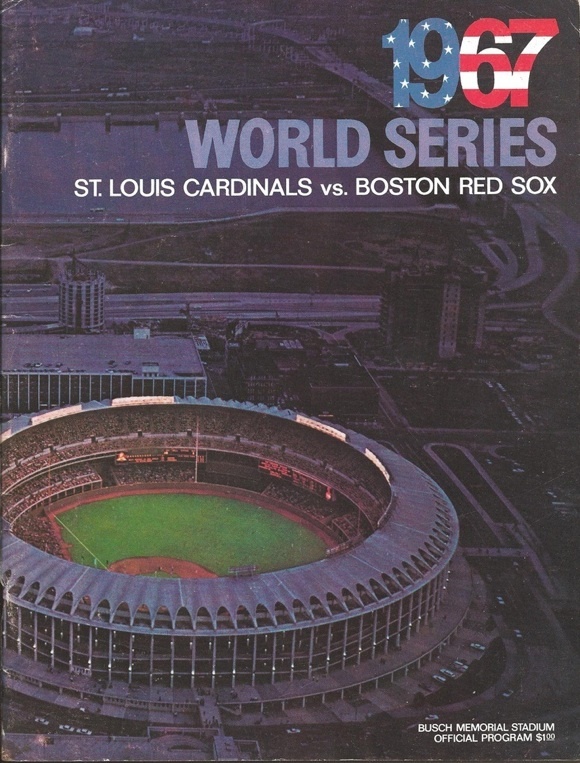
When the Boston Red Sox and the St. Louis Cardinals open the 2013 World Series tonight, it will mark the fourth time the teams have met in the ultimate postseason play. Here’s a look at the ballparks hosting the four Series.
In 1946 the Cards defeated the Red Sox, four games to three, in a World Series culminated with Enos Slaughter’s mad dash from first to home. Enos Slaughter was on first when Harry Walker hit a grounder into left center. Slaughter, who was running on the hit and run, ran through a coach’s stop sign at third and scored the winning run after Johnny Pesky failed to make an accurate throw home.
The games were played at Fenway Park and the third incarnation of Sportsman’s Park.

Boston Red Sox Johnny Pesky, Bobby Doerr, “Pinky” Higgins, Rip Russell, and Rudy York on the dugout steps at Fenway Park prior to the start of the 1946 World Series. Courtesy of the Boston Public Library, Leslie Jones Collection.

Boston Red Sox Rudy York, Red Sox coach Del Baker, St. Louis Cardinal Stan Musial, clown Al Schacht, and St. Louis Cardinal Enos Slaughter at Fenway Park prior to the 1946 World Series. Courtesy of the Boston Public Library, Leslie Jones Collection.
There were three version of Sportsman’s Park: the 1881 ballpark originally known as Grand Avenue Ball Grounds at the corner of Grand Boulevard and Dodier Street, the New Sportsman’s Park built northwest of the original ballpark, and the third version, built in 1902. Sportsman’s Park III was built by the owners of the American League’s St. Louis Browns after the franchise was shifted from Milwaukee. That ballpark underwent significant changes over the years: the original 1902 wooden grandstand was replaced in 1909 by a steel-and-concrete grandstand. At the time the Brownies were the big attraction in town: a winning team caused owner Phil Ball to increase capacity at Sportsman’s Park to 30,000 in 1922, and the St. Louis Cardinals, unable to raise funds to build a new ballpark to replace the second Sportsman’s Park, ended up sharing the third Sportsman’s Park with the Browns beginning in 1920.
Over the years the Cardinals rose and the Browns declined; the building of a strong farm system and a winning record made the Cards a better draw. Bill Veeck made a valiant run with high-profile promotions and brandings, but when Anheuser-Busch bought the Cards in 1953, Veeck threw in the towel, selling the Browns to Baltimore investors and selling the ballpark to the Cardinals for $800,000. It became Busch Stadium in 1953, but only after MLB Commissioner Ford Frick prevented Gussie Busch from naming it Budweiser Stadium. It was replaced by Busch Stadium II in 1966 and quickly torn down.

Sportsman’s Park in 1946 World Series. Courtesy of Missouri State Archives.
Notables in that 1946 World Series: Red Schoendienst, Joe Garagiola (who hit .316 in five games) and Stan Musial (who hit .222 in seven games) for the Cards; Bobby Doerr (who hit .409 in six games), Johnny Pesky and Ted Williams (who hit just .200 in seven games). Doerr, Garagiola and Schoendienst are still alive. Schoendienst enters this year’s Series as perhaps the best story of all: he’s participated in all four Boston-St. Louis World Series as a player, manager and coach. The 90-year-old still suits up for batting practice at Busch Stadium III, but fans will be able to see him decked out in red jacket when the Series shifts to St. Louis on Saturday.

Fenway Park, Game 6, 1967 World Series.
The second World Series between the two teams was played at Busch Stadium II and Fenway Park. Busch Stadium II had opened in 1966 and still had that new-car smell, hailed as the state of the art in multiuse ballparks. At the time the ballpark still featured a grass turf – AstroTurf didn’t arrive at Busch Stadium until 1970 – but it was an impressive structure, ringed by a Crown of Arches inspired by the famous Gateway Arch. It was a remarkably ambitious architectural touch from Edward Durrell Stone, better known for his art-deco and modernist creations, such as the Kennedy Center for the Performing Arts in Washington, D.C., and Radio City Music Hall in New York City. As far as cookie-cutter facilities go, it was a step above the likes of Riverfront Stadium, but it wasn’t truly a baseball facility until a 1995 renovation, which featured the installation of grass turf and a manual scoreboard.
The 1967 series was the first of six World Series to be played at Busch Stadium II; the Cards won four, including this first one, defeating the Red Sox four games to three. The Cards won the Series on the road, with Bob Gibson winning over a tired Jim Lonborg (pitching on two days’ rest). Gibson was the star of the series, allowing only three runs over three complete games, including a shutout in Game Four, while striking out 26. The series also featured two league MVPs – the Red Sox’s Carl Yastrzemski and the Cards’ Orlando Cepeda – and future Hall of Famers Lou Brock and Steve Carlton. Managing the Cards: Red Schoendienst.

It would be another 37 years until the two teams met in a World Series, and 2004 was the year when the Boston Red Sox finally broke the curse and won the series. Interestingly, the Red Sox didn’t actually win their division that season – a record of 98-64 was good only for second place in the AL East – and the World Series was not a competitive one, with the Red Sox notching a sweep. To say the Red Sox comprised a team of destiny is an understatement: the Red Sox came back from a 3-0 deficit in the ALCS to defeat the Yankees. In a nice counter to the 1967 World Series, the Red Sox clinched the championship in Busch Stadium II.
This won’t be the first World Series in Busch Stadium III: the Cards won the 2006 postseason in five games over the Detroit Tigers, while in 2011 the Cards won the World Series in seven games over the Texas Rangers. We were there for the first game at Busch Stadium III; here’s our report — overdue for an update.
